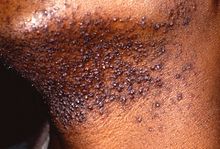Pseudofolliculitis barbae
| Pseudofolliculitis barbae | |
|---|---|
| Other names | Barber's itch, folliculitis barbae traumatica, razor bumps, scarring pseudofolliculitis of the beard, shave bumps |
 | |
| A severe case of Pseudofolliculitis barbae | |
| Pronunciation | |
| Specialty | Dermatology |
Pseudofolliculitis barbae (PFB) is a type of irritant folliculitis that commonly affects people who have curly or coarse facial hair.[1] It occurs when hair curls back into the skin after shaving, causing inflammation, redness, and bumps.[2][3] This can lead to ingrown hairs, scarring, and skin discoloration. PFB can be treated with various methods, including changing shaving habits, using topical creams or ointments, and undergoing laser hair removal. Prevention measures include proper shaving techniques, using sharp razors, and avoiding too close a shave.
It was first described in 1956.[4]
Signs and symptoms
Related conditions
Razor burn is a lesser condition caused by shaving, characterized by mild to moderate redness and irritation on the surface of the skin. Unlike PFB, it is usually transient and there is no infection involved.
There is also a condition called folliculitis barbae. The difference between the two is the cause of the inflammation in the hair follicles. Where folliculitis barbae is caused by viral or bacterial infections, pseudofolliculitis is created by irritation from shaving and ingrown hairs.
Pseudofolliculitis nuchae, a related condition, occurs on the back of the neck, often along the posterior hairline, when curved hairs are cut short and allowed to grow back into the skin. Left untreated, this can develop into acne keloidalis nuchae, a condition in which hard, dark keloid-like bumps form on the neck. Both occur frequently in black men in the military. It is so common in the U.S. military that the services have protocols for its management.[5]
Cause
Pseudofolliculitis barbae (PFB) is most common on the face, but it can also happen on other parts of the body where hair is shaved or plucked, especially areas where hair is curly and the skin is sensitive, such as genital shaving (more properly termed pseudofolliculitis pubis or PFP).[6]
After a hair has been shaved, it begins to grow back. Curly hair tends to curl into the skin instead of straight out of the
This is especially a problem for some men who have naturally coarse or tightly curling thick hair. Curly hair increases the likelihood of PFB by a factor of 50.[8] If left untreated over time, this can cause keloid scarring in the beard area.[9]
Pseudofolliculitis barbae can further be divided into two types of ingrown hairs: transfollicular and extrafollicular. The extrafollicular hair is a hair that has exited the follicle and reentered the skin. The transfollicular hair never exits the follicle, but because of its naturally curly nature curls back into the follicle, causing fluid build-up and irritation.[9]
A common
Prevention
The most efficient prevention is to grow a beard.[11] For men who are required to, or simply prefer to shave, studies show the optimal length to be about 0.5 mm to 1 mm to prevent the hair growing back into the skin.[11] Using a beard trimmer at the lowest setting (0.5mm or 1mm) instead of shaving is an efficient alternative. The resulting faint stubble can be shaped using a standard electric razor on non-problematic areas (cheeks, lower neck).[medical citation needed]
Some men use electric razors to prevent PFB. Those who use a razor should use a single blade or special wire-wrapped blade to avoid shaving too closely, with a new blade each shave.[11] Shaving in the direction of hair growth every other day, rather than daily, may improve pseudofolliculitis barbae. If a blade must be used, softening the beard first with a hot, wet washcloth for five minutes or shave while showering in hot water can be helpful. Some use shaving powders (a kind of chemical depilatory) to avoid the irritation of using a blade. Barium sulfide-based depilatories are most efficient, but produce an unpleasant smell.[11]
Treatment
The simplest treatment for PFB is to let the beard grow.[11] Complete removal of the hair from its follicle (epilation) is not recommended. Severe or transfollicular hairs may require removal by a dermatologist.[medical citation needed]
For most cases, completely avoiding shaving for three to four weeks allows all lesions to subside, and most extrafollicular hairs will resolve themselves within at least ten days.[11]
Medications may also be prescribed to speed healing of the skin. Clinical trials have shown
Long-term therapies
Permanent removal of the hair follicle is the only definitive treatment for PFB.
Legal
In 1991, the
See also
- Laser hair removal
- List of cutaneous conditions
References
- ISBN 978-1-9751-6147-7.
- ISBN 978-1-4160-2999-1.
- ^ "pseudofolliculitis barbae" at Dorland's Medical Dictionary
- PMID 4436875.
- ^ Pseudofolliculitis of the beard and Acne Keloidalis Nuchae (PDF). Department of the Army. 10 December 2014. Technical Bulletin TB MED 287. Archived from the original (PDF) on 27 July 2018.
- ISSN 0003-987X.
- PMID 31354326.
- ^ PMID 15086549.
- ^ ISSN 0147-7633. Retrieved 2021-03-25.
- ^ PMID 15086588.
- ^ ISBN 9780849314025.
- S2CID 44991940.
- PMID 15228130.
- ^ S2CID 20876126.
- PMID 2746004.
- PMID 11357287.
- PMID 22052301. Retrieved 2023-03-07.
- ^ Bradley v. Pizzaco of Nebraska, Inc., 926 F. 2d, 714 (8th Cir. 1991).
- ^ Fitzpatrick v. City of Atlanta, 2 F.3d 1112 (11th Cir. 1993).
